The Most Beautiful Landmarks in Africa You MUST SEE in Your Lifetime
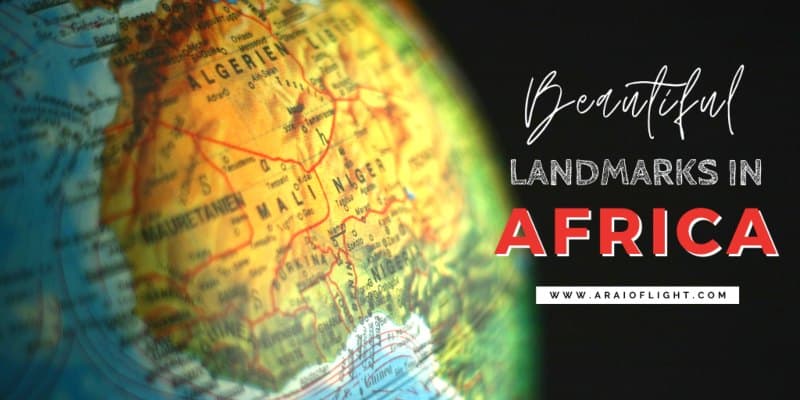
The continent of Africa is unlike any other part of the world you’ve experienced before. This vast land, comprising 54 countries and 144 Unesco World Heritage Sites, provides visitors with the chance to experience a wide variety of cultures, interesting history, natural scenery, incredible wildlife, and some of the most fascinating African landmarks around the world. These famous landmarks in Africa, both natural and man-made, offer a glimpse into both the well known as well as the untold stories of Africa. To give you a whole lot of inspiration for your next trip, here are a handful of the best tourist attractions and places in Africa that are well worth a visit. Let’s take a look….
What is Africa famous for?
It would be impossible to count the number of beautiful places on Africa that have been created, carved, and shaped by Mother Nature. From the longest river and oldest mountains on Earth to the largest waterfall, the largest hot desert, and the largest inland delta, the mainland has it all.
The Mother Continent has also been inhabited for over 5 million years, making it the oldest inhabited region, and humans have been leaving their mark here ever since.
From magnificent pyramids and palaces to monoliths and rock art, Africa is home to some fascinating historically significant sites that have been left behind by its many great civilisations.
Check out this list of amazing sites of natural beauty and cultural importance inspired by their unique design, location, significant contributions, and natural features. Africa’s landmarks are remote treasures waiting to be discovered.
So what are you waiting for?
>> Read Next:
- List: Richest countries in Africa in 2024 ranked by GDP
- 100+ quotes about Africa to inspire and amazing African proverbs
- The best tropical islands to visit in Africa (and around the world)
- Why are African sunsets so beautiful? (+ where to find ’em)
- What is the safest country in Africa? Revealed here
- Playlist: My 100 best African songs of all time
- List: The 10 best countries in Africa in 2024
- Revealed: Where to find the best safari in Africa
Beautiful Places:
15 Famous AFRICAN LANDMARKS to see
What famous landmarks are in Africa?
Continue reading to find out…. ↓↓
You will find a mix of both awe-inspiring natural scenery and ancient historic man-made monuments. This is why Africa is so special: It effortlessly intertwines the existence of man and nature and offers something for every type of traveller.
Whether you’re an intrepid explorer, an animal lover, an outdoor enthusiast, a genuine travel lover, a history buff, a beach bum, or a city explorer, you’re guaranteed to find something for you 🙂
Here are the top attractions and landmarks that await you in Africa…
1 | The Great Pyramids of Giza, Egypt
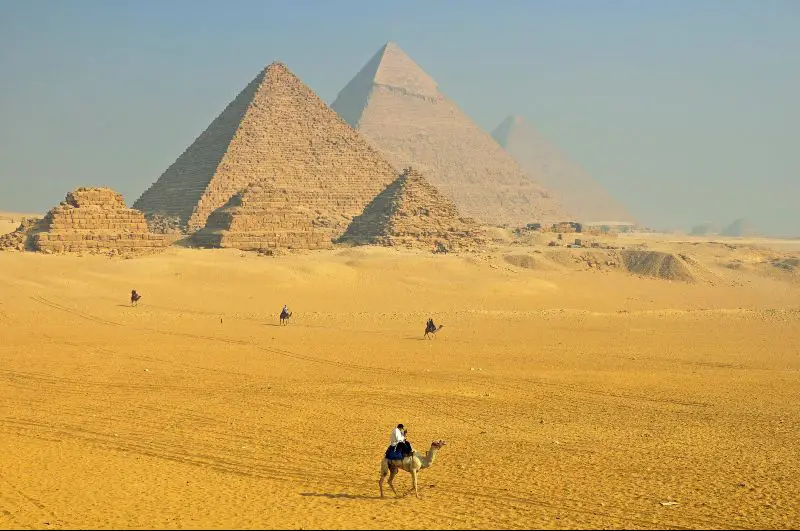
First up on this list of remarkable African landmarks is the Great Pyramids of Giza and the Sphinx: the only one of the ancient Seven Wonders of the World still in existence and the oldest man-made tourist attraction in Africa, and around the world.
For a long time throughout history the great pyramid was the tallest man-made monument on Earth. The list of accolades and attributes are endless.
Yet, to this day the Pyramids of Giza remain a mystery and scientists have failed to come up with a reasonable explanation as to how these colossal structures were built. These landmarks do however, reveal important glimpses of an ancient civilisation.
The shape of the pyramids have been designed in such a way as to conjure the rays of the sun between heaven and earth while the walls of the interior were often decorated with sacred art, inscriptions, and carvings.
Did you know:
The Pyramids of Giza date back more than 4,500 years and are large enough to be seen from outer space.
They were built as temples for the gods and as tombs for the pharaohs, filled with all items deemed necessary for the next world. The oldest and largest of these is Khufu’s pyramid, rising to a height of 146 meters (481 feet).
The Great Pyramid has some other mind-blowing facts: it was constructed around 2650 BC aligned towards true north, with each of its four sides facing a cardinal direction. The monument comprises 2,3 million granite and limestone blocks, each weighing 7 tons on average and a total combined weight of 6,840,000 tons.
Archeologists detail that on its completion it was the tallest structure on Earth and remained so for over 3,800 years. Inside you will find the King’s chamber, the Queen’s chamber, and another unfinished chamber in the basement.
>> Planning a trip? Must read:
Essential Egypt travel tips to know before you go
Thousands of monuments from the Old Kingdom of Egypt stand across modern-day Egypt, but the Sphinx and the Great Pyramids of Giza are the most legendary and well-known.
Located a short distance from Cairo city centre it is possible to visit this awe-inspiring tourist attraction independently or with a guide. A famous landmark in Africa, it remains one of the most remarkable ancient man-made structures in the world.
You really need to see it with your own eyes to believe it.
Other landmarks in Egypt include:
Abu Simbel, Karnak Temple, the Valley of the Kings, the Nile River, and the Colossi of Memnon.
2 | Mount Kilimanjaro, Tanzania
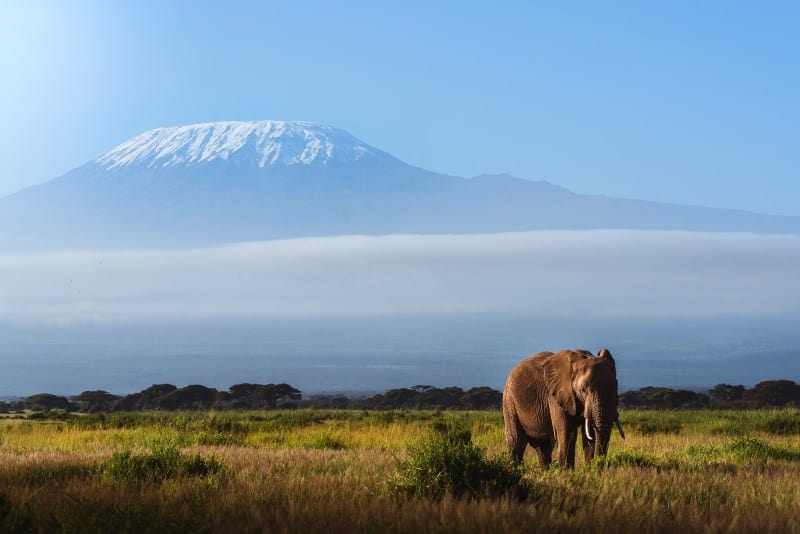
You simply cannot have a list of landmarks on African soil without the mighty Mount Kilimanjaro: The highest mountain in Africa. With its snow-capped peak rising above the clouds to a height of 5,895 metres (19,341 ft) above sea level it is also the highest freestanding mountain in the world.
Did you know:
Located in northern Tanzania, Kilimanjaro is a dormant volcano with three volcanic cones namely Kibo, Shira, and Mawenzi. The highest point is Uhuru Peak situated in Kibo’s crater rim.
The summit of Mount Kilimanjaro features the Furtwängler Glacier. This is just a small remainder of an enormous ice-cap which once crowned the top, and will most likely disappear entirely over the next couple of years.
Kilimanjaro is also one of the most famous places in Africa. Climbing Kili and reaching the top of the African continent has become a popular attraction and bucket-list item among the adventurous travellers.
Earning the right to say you’ve stood at the top of the world’s tallest freestanding landmark hails outdoor enthusiasts and mountaineers from around the world. Its popularity is also due to it being considered the easiest of the seven summits, requiring no technical climbing skills.
Although, I must add that Kilimanjaro is no walk in the park and does require one to have a decent level of fitness and endurance. The climb is also relatively affordable and doesn’t require a huge time commitment.
How long does it take to climb Kilimanjaro?
Full details + the different Kili summit routes guide here
Another attraction of Kilimanjaro is the beautiful and varied scenery, both on the mountain and in the surrounding landscape. The region offers an array of diverse habitats and environments as you make your way up the mountain.
Kilimanjaro National Park protects the encircling plains that are home to elephants, antelope, buffalo, and a variety of birds and smaller species. Lush montane tropical forests cover much of the foothills before making way for the cloud forest, alpine desert, and sparkling vista of glaciers, snow and ice.
Other landmarks in Tanzania include:
the Ngorongoro Crater, Serengeti National Park, and Tarangire National Park.
Mount Kilimanjaro is an African icon and a world famous landmark around the world. It is a special experience to walk in its shadow surrounded by the beauty of the land. It is a special feeling to stand on the roof of Africa and this experience comes highly recommended.
3 | Table Mountain, South Africa
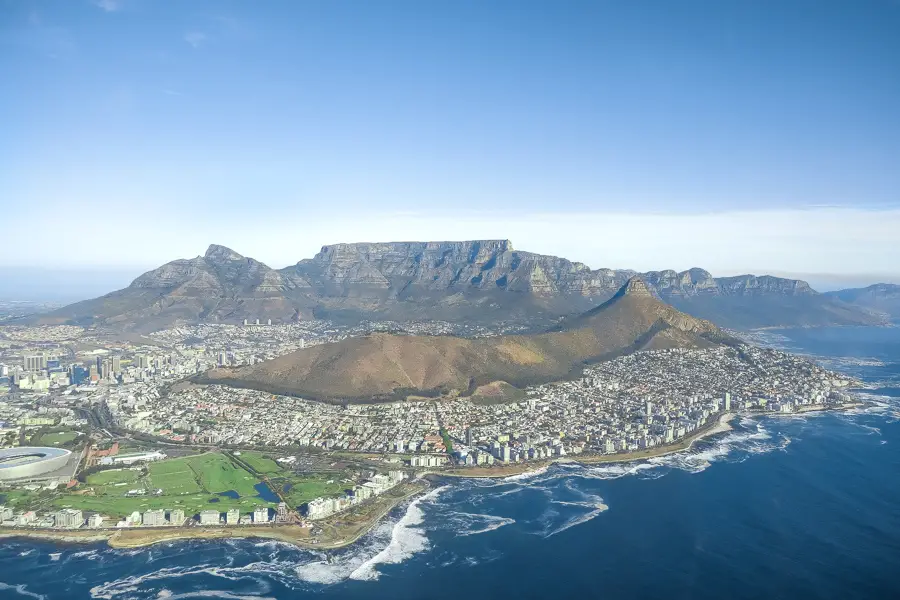
The most photographed and iconic landmark in the country, Table Mountain stands prominently over the city of Cape Town and Table Bay. Named after its flat top tabular shape, the distinctive-looking mountain rises to a height of 1086 m (3563 ft) above sea level.
Table Mountain is considered to be one of the oldest mountains in the world with the rocks of the mountain being over 60-million years old. The immense plateau is flanked by Lion’s Head on one side and Devil’s Peak on the other.
Did you know:
The highest point on Table mountain, Maclear’s Beacon, can be found on the eastern edge of the plateau towering 3,563 feet above sea level.
>> Related reading:
The best travel tips for visiting South Africa
This popular tourist attraction in Africa offers an abundance of activities, in addition to providing a breathtaking view of the surrounding city below. Hiking, camping, and abseiling, are just some of the many activities on offer. The top of the mountain can also be reached via a 5-minute cable car ride.
Hundreds of trails and steep rocky paths lead through one of the most biodiverse places in the world.
The unique vegetation comprises over 2000 various plant species that are only found in this floral kingdom. Also keep an eye out for the Rock Hyrax dassie, the Chacma Baboon, the Table Mountain ghost frog, and the many porcupines, tortoises, snakes, and lizards that call this area home.
Table Mountain remains a top sight to visit in Africa. It charms every visitor with its beauty and rawness, and should not be missed as one of the best places to visit in South Africa for first time visitors.
Other South African landmarks include:
the Blyde River Canyon, Kruger National Park, Drakensberg, Cradle of Humankind, and Robben Island, to name a few.
4 | Victoria Falls, Zambia + Zimbabwe
One of the Seven Natural Wonders of the World, the Victoria Falls is famous for being the largest waterfall, not only on the African continent, but in the world. This spectacular natural sight in Africa forms the border between Zambia and Zimbabwe on the Zambezi River in Southern Africa.
Did you know:
Spanning 1,708 metres (5,604 ft) wide and rising 108 metres (355 ft) high, Victoria Falls is the largest body of falling water on planet earth with an average flow rate of 1 million litres per second.
One of the most breathtaking falls in the world and a famous landmark in Africa it was declared a UNESCO World Heritage Site in 1989.
Fondly named Mosi-oa-Tunya meaning ‘the smoke that thunders,‘ this natural wonder can be heard, seen, and felt from miles around as the Zambezi River plunges over a cliff and into the Boiling Pot before flowing through a sequence of gorges.
Victoria Falls is protected within the Mosi-oa-Tunya National Park in Zambia and the Victoria Falls and Zambezi National Parks in Zimbabwe. You can view the grand waterfall from either country or even better, from both sides in a day.
The closest tourist towns to the falls are Livingstone in Zambia and Victoria Falls town in Zimbabwe. The Zambian side comprises closer viewpoints for a better feel of the power and magnitude of the falls as you get soaked, while the Zimbabwean side is further away for better photographs and overall perspective.
This popular natural landmark site is also well-known as the adventure capital of Africa with a plethora of adrenaline-inspiring activities. The most desired of these is the 111 metre (364 ft) bungee jump from the bridge above the falls into the gorge below.
Other things to do include microlight flights, wildlife safaris, whitewater rafting, zip-lining, and others. You can even swim in the natural rock pool called Devil’s Pool situated right at the edge of the falls on the Zambian side during the dry season.
Victoria Falls is an awe-inspiring sight to behold as the widest single-sheet waterfall in the world and a must visit African tourist attraction.
Other landmarks in this region include:
Great Zimbabwe, Lake Kariba, Hwange and Mana Pools National Parks.
5 | The Pyramids of Meroë, Sudan
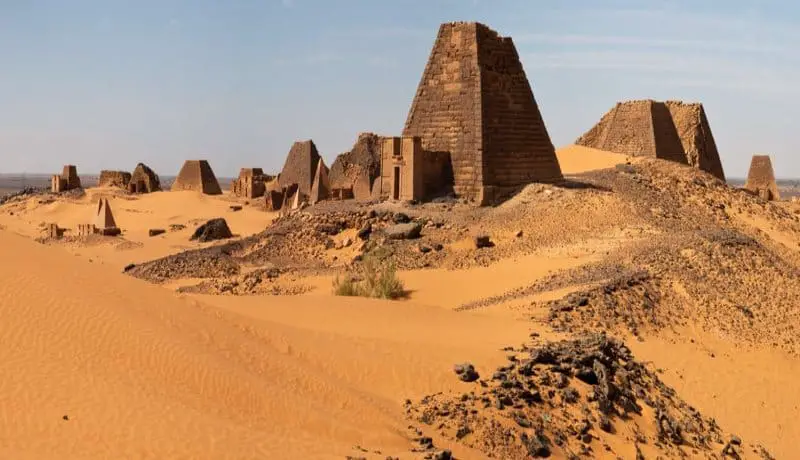
Deep in the desert of eastern Sudan lies a fascinating collection of almost 200 primordial pyramids. These ancient pyramids of Meroë were once part of a thriving and prosperous civilization. Today this remote destination in Africa is the biggest archaeological landmark site in Sudan and the country’s most impressive tourist attraction.
Did you know:
Established in the 1st millennium BCE, Meroë was once a famous and wealthy city of the ancient kingdom of Kush. It became the administrative centre of the kingdom around 750 BCE and later became its capital.
The pyramids were built by the rulers of the ancient Kushite kingdoms and many served as tombs of the Kings and Queens who ruled the area for over 900 years. The ruins lie deep in the Sudanese desert, 3 hours from the capital Khartoum. Situated along the banks of the Nile River, they extend over a square mile in area.
The ruins were discovered in the 19th century. Excavations in the early 20th century revealed an enthralling array of pyramids, palaces, and temples. In 2003 Meroe was added to the UNESCO list of World Heritage sites.
The Pyramids of Meroë, built between 2,700 and 2,300 years ago, are considered Nubian pyramids. Smaller than those found in Egypt, they are characterized by narrow bases and steep angles of the sides.
Although the pyramids are a noteworthy African landmark attraction and high in fascination and appeal, it doesn’t receive many visitors. This is not only due to its remote location, but also as a result of a series of economic sanctions imposed on Sudan and the country’s civil war.
While Sudan doesn’t feature on a whole lot of travelers’ bucket list destinations, the pyramids of Meroë are high up on my list of beautiful places to visit in Africa. How about you?
6 | Okavango Delta, Botswana
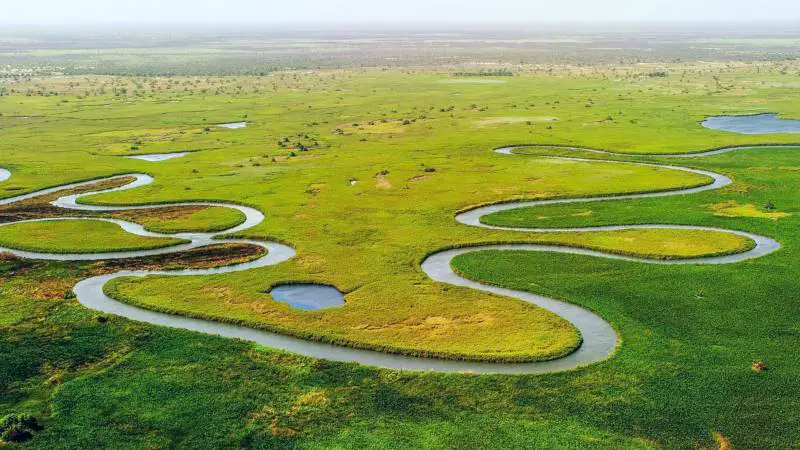
One of Africa’s most famous destinations, the Okavango Delta found in north-western Botswana is the largest inland delta in the world. Forming part of the Great East African Rift Valley system, this pristine oasis is created as the Okavango River flows into the Kalahari Desert.
This floods the surrounding savannah, creating a maze of waterways and a dynamic ecosystem that is continuously changing and spread over 15,000 kilometres.
Did you know:
The Okavango Delta is unique in that while most river deltas lead to an ocean, the Okavango river empties onto open land instead. Also referred to as the Jewel of the Kalahari, this delta covers around 15,000 square kilometres of Kalahari desert in northern Botswana.
The Okavango is a seasonal river formed as a result of the summer rainfalls in the Angolan highlands between the summer months of December and March. From March to June the water overflows into flood plains causing the delta to swell almost three times in size.
A sanctuary for a plethora of species, the Okavango Delta is a well regarded safari attraction in Africa. This abundance and diversity makes it one of the best places on the African continent to see wildlife in their natural habitat.
Keep an eye out for cheetahs, African elephants, black rhinos, lions, African wild dogs, buffalo, hippopotamus, and crocodiles, just to name a few of the many animals to be found within the delta. Other activities on offer here include fishing, birding, boating safaris, and cultural interactions in local villages.
All of this makes the Okavango Delta worthy of being on the list of the Seven Natural Wonders of Africa Landmarks. Another must visit landmark in Botswana is the Chobe National Park.
7 | Rock-hewn Churches of Lalibela, Ethiopia
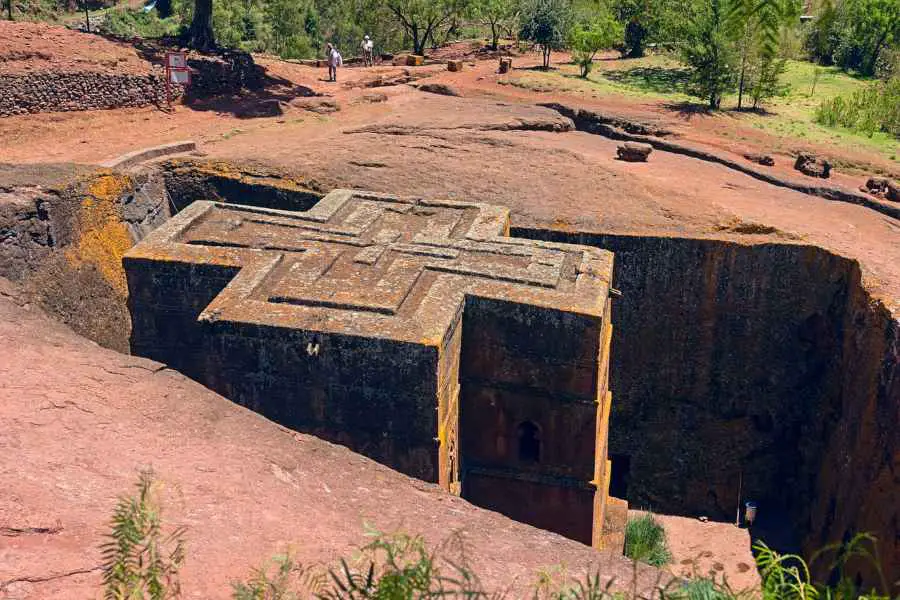
One of the most unique and mystical places in Africa, the small town of Lalibela in north-central Ethiopia is world-famous for its eleven rock-hewn churches.
These spectacular churches are unique in the sense that they were not constructed in a traditional way, but carved and cut from the living rock of monolithic blocks.
Did you know:
Dating back from the 7th to 13th century, the churches have been a pilgrimage site for Coptic Christians since the 12th century.
To this day, centuries after being built, these manmade landmarks in Africa still attract more than 100,000 Orthodox Christians pilgrims, particularly around holy days.
>> Related reading: What is…
The smallest country in Africa?
Zagwe king Lalibela commanded the construction of 11 monolithic churches in an attempt to build a new Jerusalem as his capital. This was in response to the capture of old Jerusalem. The layout and names are considered to be a symbolic representation of Jerusalem.
Regarded as a wonder of the world, each church was hewn from a single piece of solid rock to symbolize spiritual unity and humility. Subterranean passageways and twisting tunnels connect these buildings of elegant architecture.
The 11 churches are arranged into two main groups with the most notable being the House of Medhane Alem, the House of Golgotha, and the House of Mariam.
These religious monuments in Africa are among some of the most spectacular historic sites in the world. They are also the best-known attraction in the country. Other landmarks in Ethiopia include the Danakil Depression, the Rift Valley, and the Blue Nile falls.
8 | Sahara Desert of North Africa
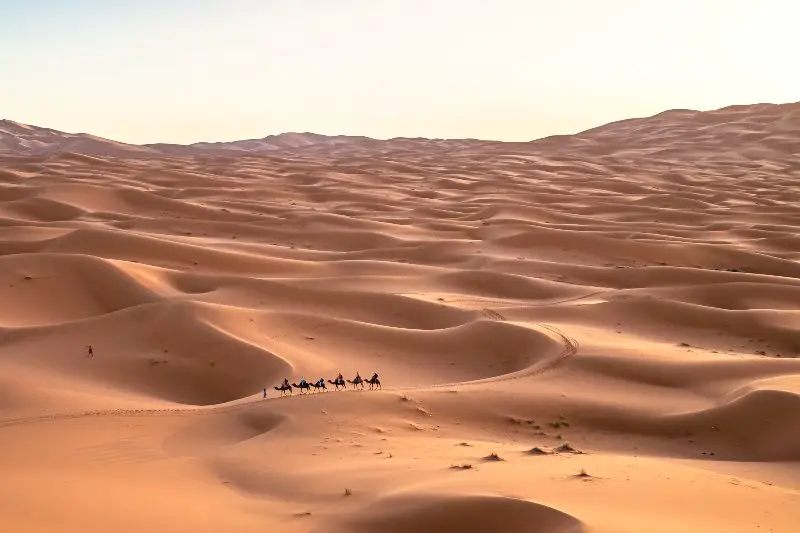
Covering an area of 9,2 million km² (3.5 million square miles), the Sahara Desert is the largest hot desert in the world. Just imagine, it occupies a total of 8% of the earth’s land area.
This noteworthy top Africa landmark spans 11 countries across much of northern Africa: Egypt, Morocco, Western Sahara, Mauritania, Algeria, Libya, Chad, Mali, Niger, Sudan, and Tunisia.
Did you know:
More than 11,000 years ago the Sahara used to be a fertile land with growing crops. However, due to a change in the tilt of the orbit of the Earth, the land began to dry up and transformed into a desert landscape. The landscape of the Sahara is not only made up of sand dunes but also includes oases, mountains, and extinct volcanoes.
The name Sahara is derived from the Arabic word ṣaḥrā and its plural form, ṣaḥārā. The high position of the sun, the lack of rainfall, and low humidity makes this place one of the hottest places not only in Africa, but on Earth.
Despite its huge size, the Sahara continues to expand, growing by 10 percent over the last century. This is mainly due to a combination of natural climate changes and global warming.
This unique attraction in Africa is a must visit place. Adventurous travelers are enticed by the tranquility, the beauty, the sky full of stars at night, and the bedouin vibes. Keep an eye out for camels, oryx, cobras, Barbary sheep, and dama gazelle, just to name a few of the animals that call this desert landmark home.
9 | Avenue of the Baobabs, Madagascar
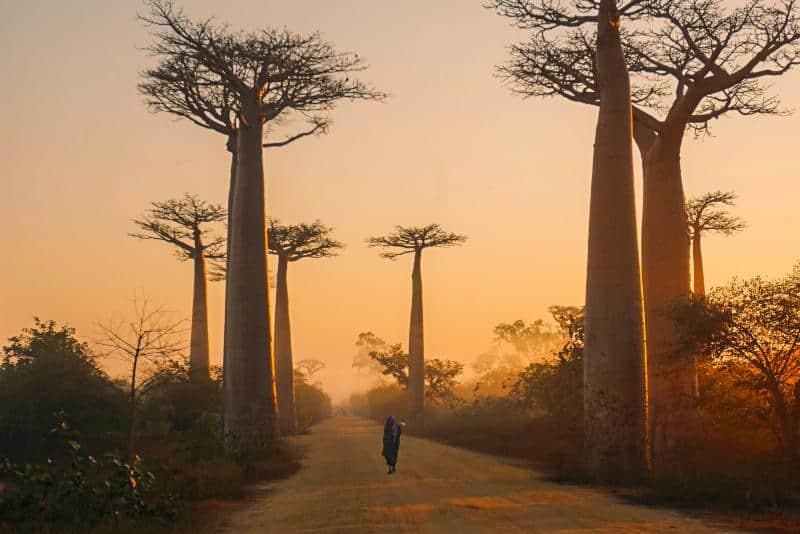
A unique place in the world and a definite landmark in Africa, the Avenue of the Baobabs can be found on the island of Madagascar. The largest island in Africa (and the 4th largest in the world), Madagascar is located in the Indian Ocean, just off the coast of southeast Africa.
It has been isolated for over 80 million years so many of its animals and plants are found nowhere else in the world.
The Avenue of the Baobabs is a collection of visually powerful Baobab trees lining a stretch of road in western Madagascar. This dirt road is a national highway (Route Nationale N8) between Morondava and Belon’i Tsiribihina in the Menabe region, about 660 kilometres from the capital Antananarivo.
Did you know:
The Baobab trees, endemic to Madagascar, belong to the species Adansonia Grandidieri and are estimated to be around 2,800 years old.
Rising up to 30 metres (100 feet) high, the dimensions of these giant trees can reach a diameter of 11 metres (35 feet), and a circumference of 50 metres (160 feet).
One of the most iconic places in Africa, the beautiful road has deservedly become a major tourist attraction. Travellers from across the globe visit to view this unique African landscape that is only 260 metres long, but the site of around 25 giant trees rising over 30 metres (98 feet) high makes for a dramatic site.
>> Read next:
10 best tropical vacations in the world
The Alley of the Baobabs is the focus of local conservation and since 2007 has been protected to become the island’s first national monument in Africa.
The Baobab tree is known locally as Renala which translates to ‘mother of the forest.’ It is also known as the tree of life due to its many uses. It provides shelter, food, water, natural medicine, and can even be used to make clothing and rope.
Sadly, the baobab tree is an endangered species, so my advice is to go and see them while you still can. The best times to visit this landmark is either at sunrise or sunset when the colours and the shadows are enhanced, creating a majestic site.
While here, don’t miss another famous, but lesser-known site: Baobab Amoureux. Here you will find two Baobab trees twisted together and often referred to as the Baobabs of love.
10 | Ngorongoro Crater, Tanzania
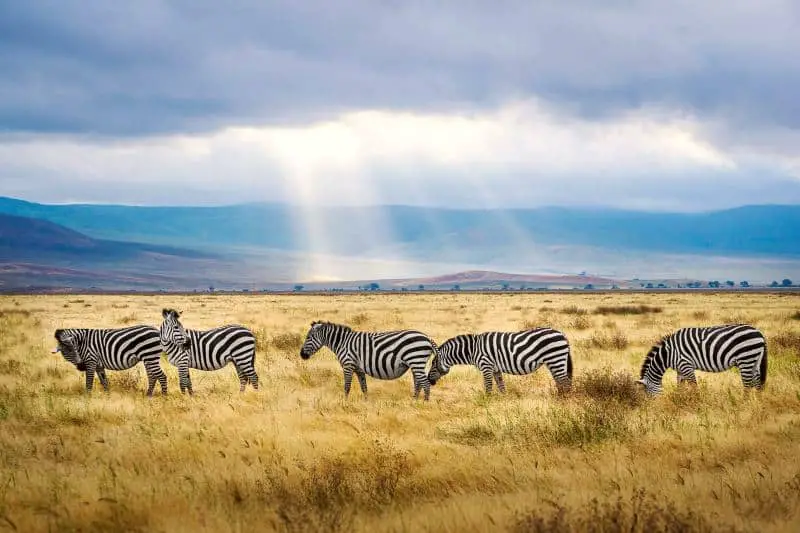
Famous for being the largest intact volcanic caldera in the world, the Ngorongoro crater is a must visit landmark African attraction.
Its formation is as a result of a huge explosion of a volcano that collapsed on itself around 2 to 3 million years ago. This volcano is believed to have been equal to or larger in size than Kilimanjaro prior to exploding.
Did you know:
The Ngorongoro crater spans 260 km² (100 square miles). It stretches 19 km (11,8 miles) across and over 600 metres (1,968 ft.) deep from the rim to floor.
Often referred to as Eden of Africa, the conservation area is home to the highest density of big game, making it one of the best places in Africa to witness wildlife in their natural habitat.
The caldera acts as a haven for more than 25,000 large animals that include lions, hyenas, wildebeest, zebra, rhinoceros, and elephants to name a few. It got its name from the Maasai people of the region, meaning “the black hole.”
Declared a UNESCO Heritage site in 1979, the region is a protected wilderness and conservation area that attracts travellers from around the world.
It is a popular destination in Africa for wildlife photography, hiking, and also mountain biking.
11 | The Great Migration across Serengeti + Masai Mara
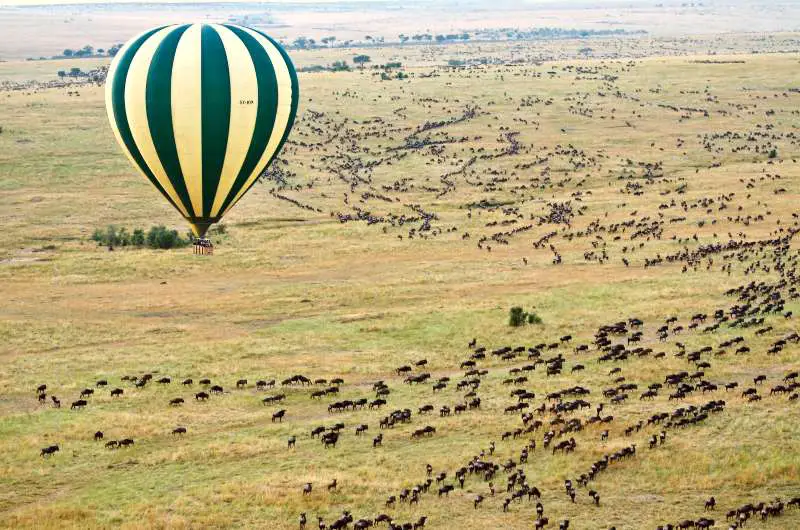
The greatest show on earth — that is what the movement of the wildebeest and zebra, followed by their predators, across the vast plains of Africa is often referred to as.
This great migration of over 2 million animals is the largest wildlife migration in the world during which the animals move in a clockwise direction across some of the most beautiful places in Africa: the Serengeti in Tanzania and the Masai Mara in Kenya.
Did you know:
The best places to observe the movements of the great migration is along the Ndutu Plains, the flashpoint of the Mara river, and the plains of the Masai Mara.
The Serengeti National Park covers an area of 14,750 km2 (5,700 sq mi) of savannah, forest, and grassland. This vast ecosystem in the Mara and Simiyu regions of East Africa boasts impressive wildlife numbers with more than 300 species of mammals and over 500 species of birds.
Contiguous with the plains of the Serengeti, the Maasai Mara Game Reserve is an important wildlife conservation area covering 1,510 km2 (580 sq mi) in the Rift Valley province of Kenya.
It is world famous for its large populations of African leopard, bush elephant, and lion amongst a variety of other wild creatures.
The best time to visit these natural landmarks and witness the migration spectacle is between the months of July and October. During July and August the wildebeest cross the Mara river into Kenya’s Maasai Mara. In the latter part of September and October, as the rainy season commences in Tanzania, the herd will embark on their return journey back to the Serengeti.
The Serengeti and Masai Mara are tourist attractions and famous African landmarks in and of themselves.
Add to this the sight of millions of animals in motion and you’ve got yourself one of the most awe-inspiring natural spectacles in the world. No trip to Africa is complete without this experience.
12 | Fish River Canyon, Namibia
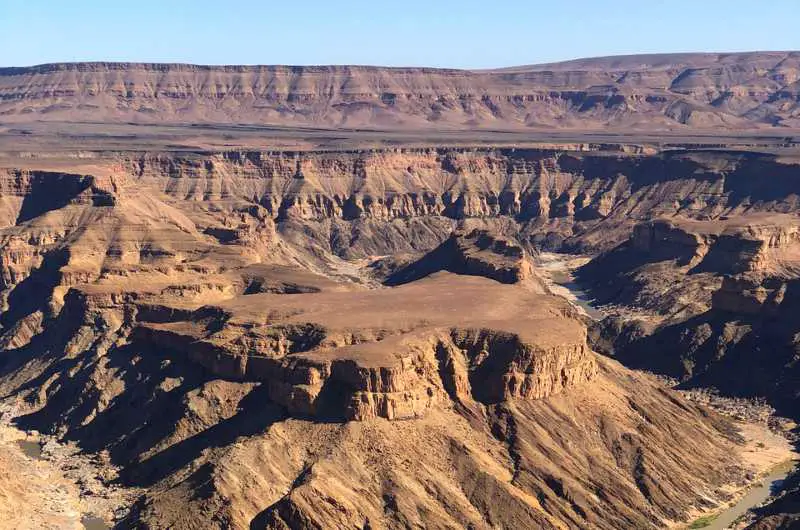
Number 12 on this list of eminent and renowned landmarks of Africa is the Fish River canyon. Located in the South of Namibia, it covers an area of 5,900 km2 (2,300 sq mi), making it the second largest canyon in the world and the largest on the African continent.
The vast expanse and rugged terrain draws visitors from around the world as the second most visited attraction in Namibia. Hiking is a popular activity that provides a great way to experience the magnitude and raw power of this natural landmark.
One of the best lookout points is Hell’s Bend, located near the Hobas rest camp, and from this vantage point witness the deep canyon infinitely spread out as far as the eye can see.
This landmark and natural wonder was formed by water erosion and the collapse of the bottom of the valley. Carved by the Fish River, the canyon forms part of the Ai-Ais Richtersveld Transfrontier Park.
Did you know:
The Fish River Canyon is over 500 million years old and comprises a massive ravine around 100 miles in length, up to 30 km wide and 549 metres deep. It was declared a National Monument of Africa in 1962.
13 | Timbuktu and the Great Mosque of Djenne, Mali
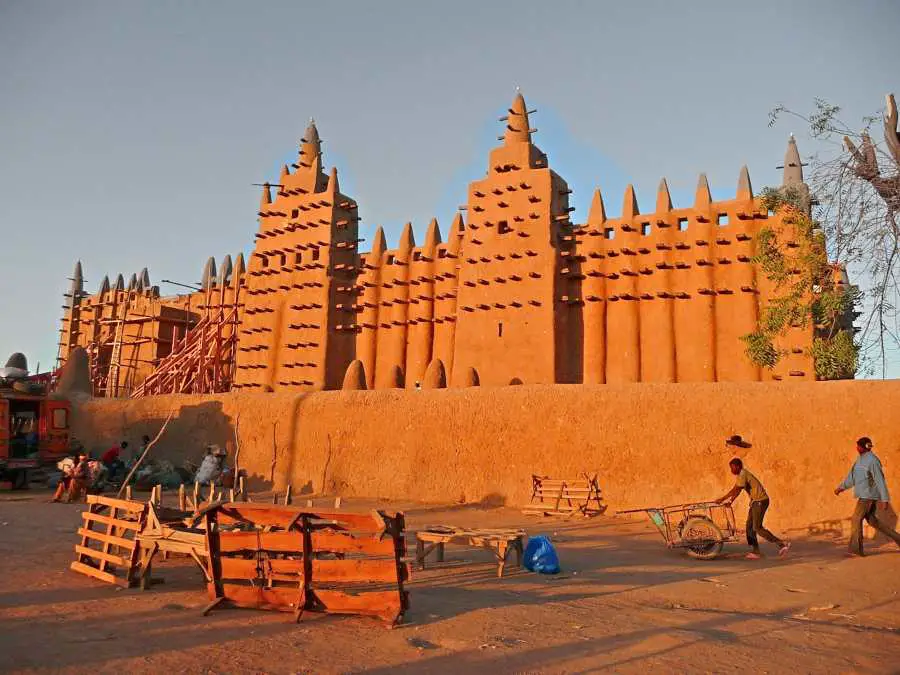
I’m willing to bet you’ve used the phrase “from here to Timbuktu,” at least once to to describe a faraway, secluded enigmatic sanctum.
Well, did you know that Timbuktu is an actual real place? Timbuktu is the capital city of Mali, located on the southern threshold of the Sahara near the Niger River.
Did you know:
The first settlement of this Medieval place in Africa dates back to the 12th century. Lying on the ancient trade route of the Mali Empire, the town was an important trans-Saharan trading marketplace where caravans traded desert salt for gold, ivory, grain, and manuscripts.
This UNESCO world heritage site from Africa was also an intellectual and spiritual centre of Islam in Africa during the 15th and 16th century. Home to the esteemed Koranic Sankore University and other madrasas; it attracted scholars from across the Islamic world.
Its three great mosques, still standing and continuously maintained, Djingareyber, Sankore and Sidi Yahia dominate the landscape and evoke Timbuktu’s golden age.
Situated a short distance from Timbuktu is one of the most famous landmarks in Africa: The Great Mosque of Djenné. Located in the city of the same name on the flood plain of the Bani River, the adobe building is a site to behold and considered to be one of the greatest feats of the Sudano-Sahelian architectural style.
Originally built in the 13th century, made entirely out of mud, it was later demolished. It was only in 1907, during which Djenné had become a French colonial outpost that the mosque was reconstructed on the site of the original one.
Over the centuries, the Great Mosque of Djenné has become the cultural and religious centre of Mali. Each year the town gathers for the unique Crepissage de la Grand Mosquée (Plastering of the Great Mosque) festival during which repairs on the mosque sustained over the previous year are carried out.
This man made historic monument is built on a platform measuring about 75 m × 75 m (246 ft × 246 ft) that is raised by 3 metres (9.8 feet) above the level of the surrounding marketplace.
A distinctive feature of the mosque is the rodier palm sticks that protrude from the building. Originally used as decoration, they now also serve as scaffolding during repairs.
Other landmarks in Mali are the Tomb of Askia and the Hand Of Fatima. Timbuktu and the Great Mosque of Djenné are among some of the most unique places in Africa that every adventure traveller needs to see.
14 | Sossusvlei, Namibia
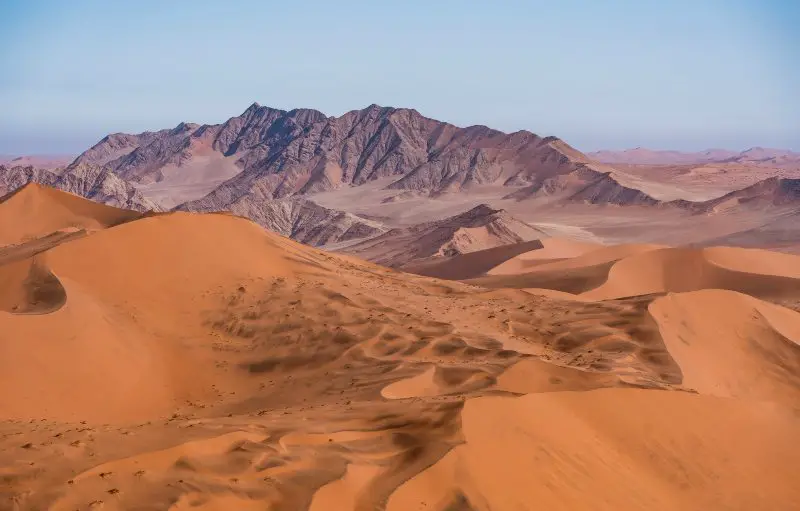
Sossusvlei is arguably Namibia’s most impressive and best-known tourist attraction. Set within the Namib-Naukluft National Park, the largest conservation area in Africa, the region is home to the biggest sand dunes in the world.
Characterized by these massive sand dunes that surround it, Sossusvlei is a vast white clay and salt pan located within the southern part of the coastal Namib Desert.
Dating back more than 55 million years, the Namib is believed to be the oldest desert on the planet. With temperatures reaching 45°C during the day and below freezing after dark, it is also one of the most inhospitable places in Africa and around the world.
The name Sossusvlei is of mixed origin, roughly translating to “dead-end marsh.” The desert dunes have been formed by the transportation of materials from thousands of kilometres away by wind and water currents. The orange coloured dunes comprise quartz sand that has blown inland from the coastal area.
Did you know:
The massive dunes of Sossusvlei rise up to 300 metres (1000 ft.) high. Dune 7 holds the title of the highest sand dune in the world, rising 1,256-feet high. It got its name because it is the seventh dune past the Tsauchab River, which runs through the Namib Desert.
This impressive African landmark is a great destination all year round, attracting travellers who wish to climb these sand dunes followed by an exhilarating slide back down.
It is also a highlight for those who wish to capture this unique African landscape and photogenic area on camera. Located around 350 km southwest of Windhoek, the natural attraction can be visited for a day as part of a larger road trip within Namibia.
Famous for its large, unique red sand dunes, Namibia’s most visited attraction is a definite landmark for Africa and a must visit when travelling across the great continent.
Other landmarks in Namibia include Etosha National Park, Twyfelfontein, and Skeleton Coast.
15 | The Nile River
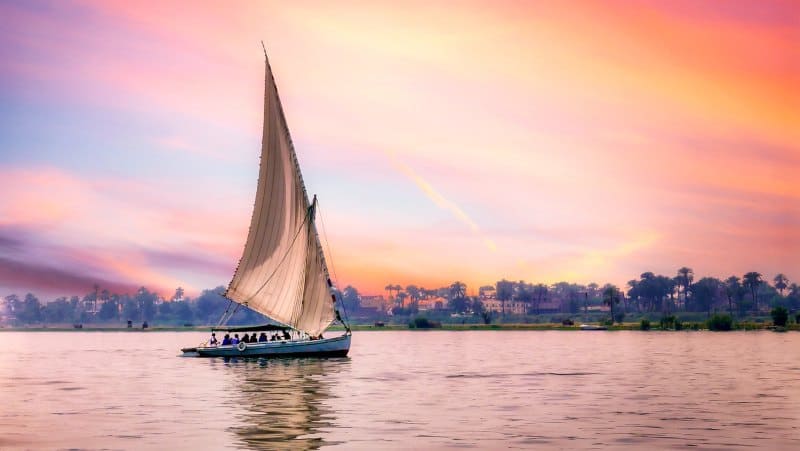
With a length of 6,852 km (4,258 miles), the Nile River is not just the longest river in Africa, but the entire world. Located in northeast Africa, the river passes through eleven countries as it flows north into the Mediterranean Sea.
Did you know:
The Nile River is more than 30 million years old. It flows through 11 nations with an average discharge of 3.1 million litres (680,000 gallons) per second.
Originating south of the equator in Burundi, the Nile has two sources: the Blue Nile from Lake Tana in Ethiopia and the White Nile from Lake Victoria in Tanzania. It takes around three months for the waters to travel the entire length of the river until it empties into the Mediterranean.
Luxury cruises are the most favoured way to see and travel along this prominent landmark in Africa. Many of these luxury liners and yachts offer planned shore trips that allow you to see the major attractions along the way that include famous tombs, temples, pyramids, as well as the Aswan Dam.
Popular activities along the Nile comprise white water rafting, jet boating, swimming, fishing, and kayaking.
Don’t miss the opportunity to visit these beautiful places in Africa landmarks.
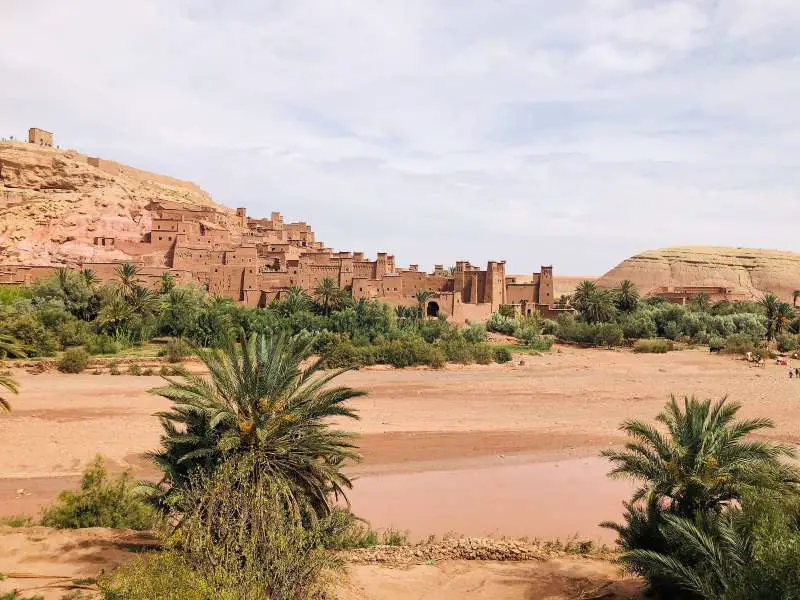
In addition to these famous places in Africa, I thought it be a good idea to expand on this list by including some other noteworthy locations. Continue reading to find out all the details:
Geographic Natural Landmarks In Africa
I’ve gathered the best of nature with this list of Africa’s most beautiful places. Find incredible attractions from towering mountains and powerful waterfalls to vast deserts and endless plains.
Be sure to check out this world geography trivia quiz to test your knowledge about the world we live in.
Kruger National Park — South Africa
Danakil Depression —Ethiopia
Mount Nyiragongo —Democratic Republic of the Congo
Mount Kilimanjaro —Tanzania
Okavango Delta —Botswana
White Desert — Egypt
Skeleton Coast —Namibia
The Vallée de Mai — Seychelles
Hand of Fatima — Mali
Tsingy de Bemaraha National Park — Madagascar
Table Mountain National Park — South Africa
Serengeti National Park, Tanzania
Hoba meteorite — Namibia
Trou de Fer canyon and waterfalls – Réunion
Victoria Falls — Zimbabwe
Nile River
Sahara Desert — North Africa
Fish River Canyon — Namibia
Aloba Arch — Chad
Zuma Rock — Nigeria
Bourke’s Luck Potholes Blyde/Molatse River Canyon — South Africa
Amguid crater — Algeria
Sterkfontein Caves — South Africa
Ngorongoro conservation area — Tanzania
Dunes of the Namib — Namibia
Le Morne Peninsula — Mauritius
Amphitheatre in Drakensberg — South Africa
Limestone chimneys of Lake Abbe – Djibouti, Dikhil
Man Made Landmarks of Africa
The continent has been inhabited by humans and their forebears for more than 4,000,000 years. Humans have been leaving their mark here ever since. From rock art to monoliths find a list of the most important manmade African landmarks:
Great Zimbabwe Ruins — Zimbabwe
African Renaissance Monument — Senegal
Kano City Walls — Nigeria
Church of Emmanuel in Lalibela — Ethiopia
Leptis Magna — Libya
Thebes and Karnak Temple Complex — Luxor Egypt
Basilica of Our Lady of Peace — Yamoussoukro Côte d’Ivoire
Great Mosque of Djenne — Mali
Pyramids of Meroe — Sudan
Amphitheatre of el Jim — Tunisia
Djamaa El Djazair — Algiers Algeria
Nabta Playa stone circle — Egypt New Valley
Pyramids of Giza — Egypt
Historical Sites in Africa
The continent has a plethora of interesting and historic sites that have been left behind by the civilisations that have called Africa home over the millennia. From ancient pyramids and castles to monuments and archeological sites, they provide a glimpse into a world gone by. Here is a list of some remarkable examples of this:
Olduvai Gorge — Tanzania
Amphitheatre of el Jim — Tunisia
Ancient Thebes with its Necropolis Luxor and the Valley of the Kings — Egypt
Archeological site of the Island of Meroe — Sudan
Archeological site of Cyrene and Leptis Magna — Libya
Archeological site of Volubilis — Morocco
Nubian monuments Abu Simbel and Philae — Egypt
Fossil Hominid Sites of South Africa
Lower valley of the Omo and Awash Valley — Ethiopia
Elmina Castle — Ghana
Ile de Goree — Senegal
Cultural Landmarks Africa
The number of Cultural World Heritage sites in Africa totals 89. Around 10% of the cultural sites are classified as cultural landscapes, a special title given to areas that represent ‘the combined works of nature and man.’ Here are a handful of the best ones:
Cradle of Humankind — South Africa
Stone circles of Senegambia — Senegal and Gambia
Robben Island — South Africa
The Church of Saint George — Ethiopia
Great Zimbabwe — Zimbabwe
Fort Jesus Mombasa— Kenya
Jemaa el-Fna Marrakesh — Morocco
Twyfelfontein — Namibia
Al-Bajrawiya — Sudan
Stone Town of Zanzibar — Tanzania
Apartheid Museum — South Africa
Valley of the Kings — Egypt
Lamu Old Town — Kenya
Royal Palaces of Aborney — Benin
Tombs of Buganda Kings at Kasubi — Uganda
Timbuktu — Mali
Dabous giraffe carvings of Agadez – Niger
Neolithic rock painting at Tassili N’Ajjer — Algeria
And that’s about it, fellow explorers.
I’ve tried to be as comprehensive with this post about Africa as possible, so I’m almost certain you’ve found what you were looking for.
Any questions about travelling or comments? Let me know ↓↓
>> Read next:
- 35 exotic + weird foods people actually eat
- The top 10 best African countries to visit as well as the best African islands
- Answered: How many countries in Africa in 2024
- What is the wealthiest country in Africa?
- What is the largest country in Africa?
- The countries with the best sunsets in Africa
- 100 + African quotes that capture the beauty of the land
- Revealed: the countries with the most beautiful flags in the world
- What are the top 10 benefits of travelling?
- How many countries are there in the world (exactly)?
With love from Africa,
Rai

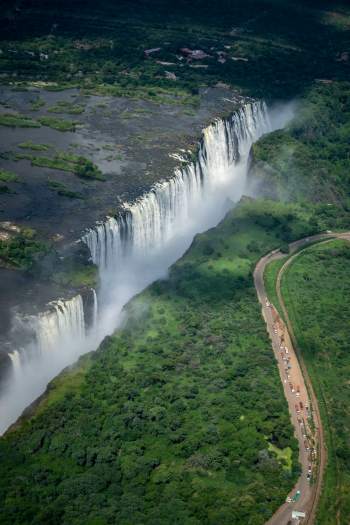
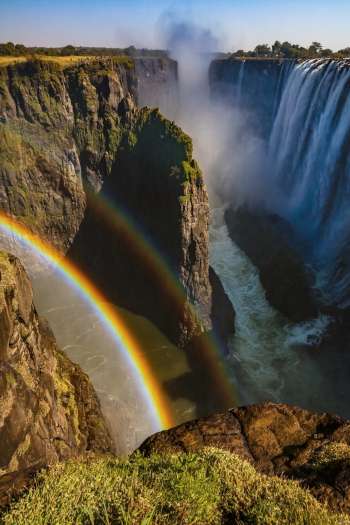
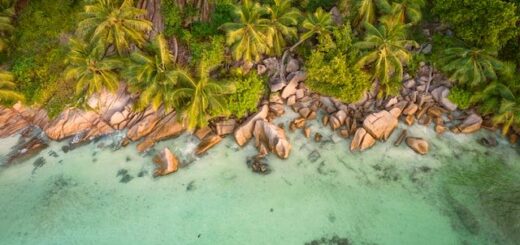

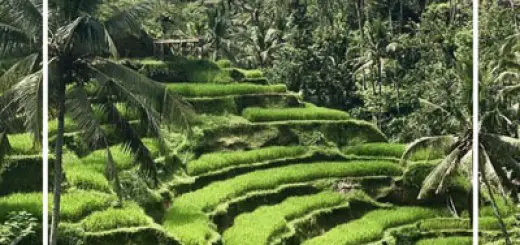
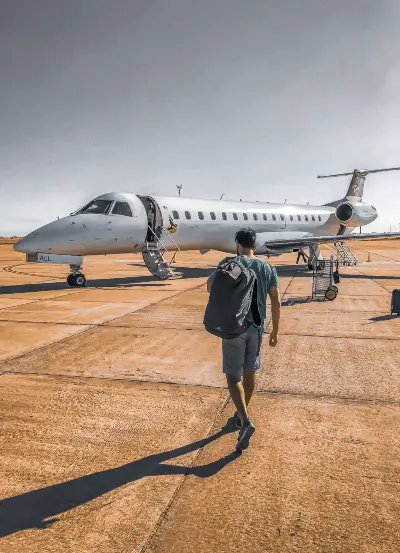 New Here?
New Here? 








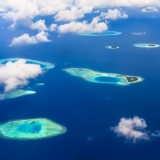


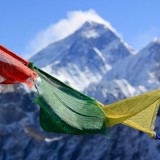
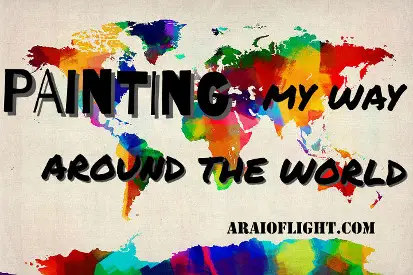
Thanks for sharing such informative post about what to see in Africa.
Thanks for reading. Please share this post with anyone you think may be interested too 🙂
Rwanda volcanic region
Thank you. I’ll have to check it out
What about Yankari game reserve of Bauchi state and Shere hills in Plateau state Nigeria among others?
You know, I haven’t even heard about these places